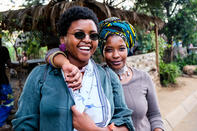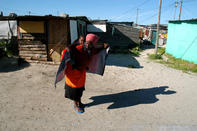Disparities Between Men and Women
When Cornelia’s second marriage ended, she learned the hard way how vulnerable a woman can be as a single-income unit. With it came a loss of material security that saw her join the 70% of the world’s poor who, around the world, are women, according to a mid-1990s estimate by the United Nations Development Programme.

This figure has not changed much during the course of Cornelia’s passage from married car guard to resident of a plakkerskamp (informal squatter camp). Disparities in income, job access and earning capacity between men and women are an almost universal product of the ongoing patriarchy that tends to pay men more for their skills than for the equivalent skills in women.
Women overwhelmingly find themselves in the lower-paying strata of the job market and often in less-skilled positions. All those hours spent taking care of the family go unpaid and they are more likely to carry the cost of looking after children. In addition, pregnancy and early childcare disrupt women’s education and work opportunities.
Impact of HIV
In sub-Saharan Africa, women are disproportionately impacted by HIV, according to the United Nations Programme on HIV/AIDS, UNAIDS. In spite of recent declines in both the rate of HIV infection and the number of AIDS-related deaths, the region still accounts for just over two thirds of the global HIV burden (68%), some 22.5 million HIV- infected people in all, while three quarters (76%) of women infected globally are in this region.
‘In nearly all countries in sub-Saharan Africa, the majority of people living with HIV are women, especially girls and women aged 15–24. In South Africa, HIV-prevalence among women aged 20–24 is approximately 21%, compared to about 7% among men in the same age range,’ states the UNAIDS global fact sheet for the region.
These are women entering their most productive years with an illness that will undermine their efforts to get educated and their ability to care for their families and earn a living. For every ten men in the region who become infected, thirteen women contract the virus.
Women in Post-Apartheid South Africa

In post-apartheid South Africa, more and more households are headed by women. Since the head of house is usually the chief earner, it is more likely that this kind of family will have a smaller income than a male-headed household.
Even though post-apartheid laws have tried to redress the job market’s bias against women, and give some support, particularly for their child caring hours, through child grants, and even though more women are moving into the job market, their ‘relative access to resources has decreased’, writes Professor Dori Posel from the University of KwaZulu-Natal’s School of Development Studies.
This is mostly due to the burden of HIV, the gap between real earnings and rising unemployment amongst women where, increasingly, the informal and low-income jobs are the ones that women end up doing. And it is a factor of basic maths that a single-income home is going to have a smaller kitty than a double-income home. It is worth noting that the measure of poverty is to look at the income per person in a household.
Posel’s analysis was based on poverty measured on figures in 2000, which at the time regarded people as ‘poor’ when they live in a household where the income per person, per month, was less than R322. Today, the South African government’s National Planning Commission measures poverty at R418 a month, per person.
‘In 2006, approximately 64.3 per cent of all South Africans would have been poor had they relied only on income earned from employment,’ writes Posel, but ‘with the inclusion of social transfers, however, the extent of poverty falls by five percentage points, to 59.1 per cent.’
Because of the strong link between income, poverty and food security in households, it is hardly surprising, then, that the African Food Security Network’s (AFSUN’s) eleven-city SADC survey found that women-headed households tended to be the most food insecure, compared with nuclear, extended or male-headed households.
Women Allocate More to Food
In her analysis of three Cape Town communities surveyed (Ocean View, Philippi and the neighbouring communities of Enkanini and Kuyasa), University of Cape Town geographer Dr Jane Battersby found something interesting: compared with other households at the same income level, women-centred households tend to be as food secure as ‘traditional’ nuclear families.
This is not just because women will allocate a bit more of the family budget to food than men will (women-centred homes put 30% of their documented income towards food, men-centred homes put 25% to food), according to Battersby.
But it could also have something to do with the fact that the division of labour around food is still largely traditional – meaning that women still tend to buy, prepare, serve up and grow the family’s food. In their control of the ebb and flow of household food supplies, women might tend to ‘buy more nutritious food staples, spend more time cooking them and allocate more equitably than in other household types’, says Battersby.
By Leonie Joubert